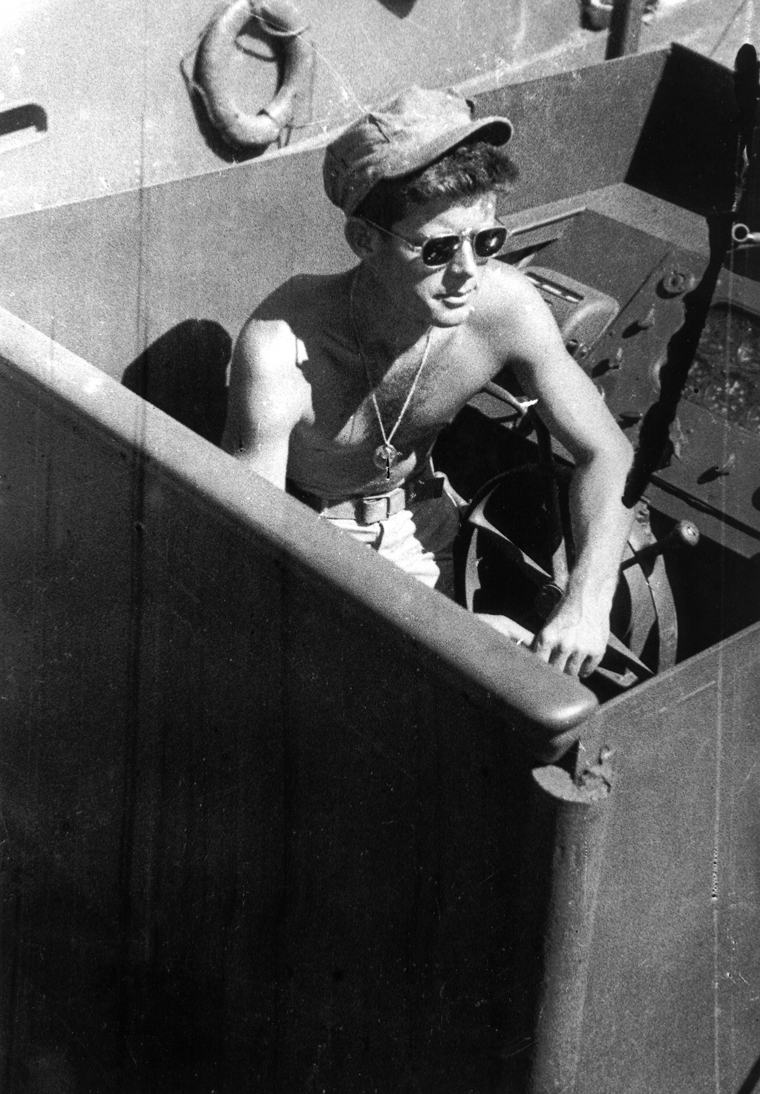PT-109 was a PT boat (Patrol Torpedo boat) last commanded by LTJG John F. Kennedy (later President of the United States) in the Pacific Theater during World War II. Kennedy’s actions to save his surviving crew after the sinking of PT-109 made him a war hero, which proved helpful in his political career.
It is arguably the most famous small-craft engagement in Naval History, and it was an unmitigated disaster. At a later date, when asked to explain how he had come to be a hero, one of the young commanders involved, by then an aspiring politician, replied laconically, “It was involuntary. They sank my boat.”
THE STORY OF PT 109
To understand the events of August 1 – 2, 1943, which culminated in the sinking of PT-109, it is important to remember that it was dark. The disorienting effect, even for experienced Sailors, of a moonless, starless night on the ocean should not be underestimated. In this profound darkness, PT-109 stood at her station in Blackett Strait, south of Kolombangara in the Solomon Islands, one of the remnants of an operation born into futility, the heir to bad planning and worse communication.
THE ACCIDENTAL HERO
Fifteen PT boats (“Patrol Torpedo” boats) had set out to engage, damage, and maybe even turn back the well-known “Tokyo Express,” the Japanese resupply convoy that enabled resistance to the advance of U.S. forces in the islands farther south. When the patrol actually did come in contact with the Tokyo Express— three Japanese destroyers acting as transports with a fourth serving as escort— the encounter had not gone well. Thirty torpedoes were fired with no more effect than to make the Japanese even warier than they had been. Boats that had used up their complement of torpedoes were ordered home. The few that still had torpedoes remained in the strait, in the doubtful hope of catching the Express on its return voyage.
PT-109 was one of the boats left behind. LTJG Kennedy rendezvoused his boat with PT-162 of his own patrol section and PT-169, which had been separated from another section, and the three boats spread out to make a picket line across the strait. At about 0230 a shape loomed out of the darkness three hundred yards off PT-109’s starboard bow. So difficult was visibility that it was first believed to be another PT. When it became apparent that it was one of the Japanese destroyers, Kennedy attempted to turn to starboard to bring his torpedoes to bear. But there was not enough time. The destroyer, later identified as the Amagiri, the escort ship of the Express, struck PT-109 just forward of the forward starboard torpedo tube, ripping away the starboard aft side of the boat. Less than a minute had passed since the first sighting.
The impact tossed Kennedy around the cockpit, and his radioman, John E. Maguire, was actually thrown from it. Most of the crew were knocked or fell into the water. The one man below decks, engineer Patrick McMahon, miraculously escaped, although he was badly burned by exploding fuel. Fear that PT-109 would go up in flames drove Kennedy to order the men who still remained on the wreck to abandon ship. But the destroyer’s wake dispersed the burning fuel, and when the fire began to subside, Kennedy sent his men back to what was left of the boat.
THE ULTIMATE SWIM CHALLENGE
Kennedy had been on the swim team at Harvard; even towing McMahon by a belt through his teeth, he was undaunted by the distance. Several of the other men were also good swimmers, but several were not; two, Johnston and Mauer, could not swim at all. These last two were lashed to a plank that the other seven men pulled and pushed as they could. Kennedy arrived first at the island, named Plum Pudding but called by the men “Bird” Island because of the guano that coated the bushes. So spent that he had to be helped up the beach by the man he had towed, Kennedy collapsed and waited for the rest of the crew.
On August 4 Kennedy led the men back into the ocean, striking out for Olasana Island in hopes of finding food and fresh water but also wishing to be closer to Ferguson Passage. Kennedy again hauled McMahon by the strap of his life vest while the rest of the crew clustered around the plank and thrashed their way along. Olasana Island proved to be something of a disappointment. The coconuts were more plentiful but had a sickening effect on some of the men. Fresh water was not in evidence, and the men were too nervous about Japanese patrols to explore more than a small corner of this larger island. When the night of August 4 turned wet and cold, Kennedy determined to try the next island over the following day.
Naru, or Cross, Island is the last in the chain, and its eastern shores look out over Ferguson Passage. Kennedy and Ross climbed up on to its beach a little past noon on August 5. Fearing enemy patrols, the two men stepped carefully through the brush but only saw the wreck of a small Japanese vessel out on the reef. On the beach they spotted a small box with Japanese labels. When they broke it open, they were delighted to discover it contained Japanese candy. Even better, a little further up the island they discovered a tin of water and a one-man canoe hidden in the bushes. Having had a drink, Kennedy and Ross were just walking back onto the beach when they saw two men out at the Japanese wreck. The men, clearly islanders, took fright and paddled away from the wreck in a canoe, despite Kennedy’s hails. Uncertain about the outcome of this encounter, that night Kennedy took the canoe into Ferguson Passage once more, with as little success as previously.
THE RESCUE
Kennedy decided to take the canoe back to Olasana; he stopped off long enough to gather the candy and the water to bring to the other men, leaving Ross to rest until the next morning. Arriving at Olasana, Kennedy discovered that the two men he and Ross had seen at Naru had made contact with the rest of the crew. The two men, Biuku Gasa and Eroni Kumana, were islander scouts for the Allies. Their hasty departure from Naru had left them tired and thirsty, and they had stopped for coconuts at Olasana, where Thom had been able to convince them that the crew was American. The next morning, August 6, Kennedy returned with Gasa and Kumana to Naru, intercepting Ross along the way as he was swimming back. The islanders showed the two Americans where a boat had been hidden on Naru. When Kennedy was at a loss for a way to send a message, Gasa showed him how it could be scratched into a green coconut husk. Gasa and Kumana left with the message—
NAURO ISL
COMMANDER . . . NATIVE KNOWS
POS’IT . . . HE CAN PILOT . . . 11 ALIVE
NEED SMALL BOAT . . . KENNEDY
— as well as a backup note that they got from Thom when they stopped at Olasana. Perhaps not fully believing that their luck had changed, Kennedy insisted on going out with Ross into Ferguson Passage in the two-man canoe. Heavy seas swamped the canoe and so battered the men that they barely made it back to Naru. But the next morning, August 7, eight islanders appeared at Naru shortly after Kennedy and Ross awoke. They brought food and instructions from the local Allied coastwatcher, Lt. A. Reginald Evans, that Kennedy should come over to Evans’s post. Stopping long enough at Olasana to feed the crew, the islanders hid Kennedy under a pile of palm fronds and paddled him to Gomu Island in Blackett Strait. Early in the evening of the seventh, a little more than six days after PT-109’s sinking, Kennedy stepped onto Gomu. There was still a rescue to be planned with Evans, no small thing in enemy-held waters, but the ordeal of PT-109 was over.
Evans had already notified Rendova of the discovery of PT 109’s survivors, and the base commander was proposing to send the rescue mission directly to Olasana. Understandably somewhat wary of the ability of such a mission to be directed from afar, Kennedy insisted on being picked up first so that he could guide the rescue boats among the reefs and shallows of the island chain. Late on the night of August 7, the boats met Kennedy at the rendezvous point, exchanging a prearranged signal of four shots. The PTs crossed Blackett Strait under Kennedy’s direction and eased up to Olasana Island early in the morning of August 8. The exhausted men of PT-109 were all asleep, and Kennedy, his relief and exhilaration enhanced by a couple of doses of medicinal brandy, began yelling for them, much to the chagrin of his rescuers, nervous over the proximity of the Japanese. But the rescue went forward without incident, and the men of PT-109 reached Rendova at 5:30 in the morning on August 8.
A HERO IS BORN
For his courage and leadership, Kennedy was awarded the Navy and Marine Corps Medal, and injuries suffered during the incident qualified him for the Purple Heart; Ens. Leonard Thom also received the Navy and Marine Corps Medal. But the consequences of the event for John F. Kennedy were more far-reaching than simple decorations for a uniform. The story was picked up by the writer John Hersey, who told it to the readers of The New Yorker and Reader’s Digest, and it followed Kennedy into politics, where it was a strong foundation of his appeal. For here was a war hero who had not won battles but who had shown courage and dogged will, responsibility for those he led and the ability to inspire them— and it would be hard to better this as a short list of qualifications for a political leader.











